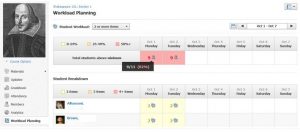Karen is a full-time secondary school teacher and department head at a small independent school in an urban area of Vancouver, British Columbia. There are approximately 350 students in grades 8-12 in the senior school. The school has been using a LMS called Schoology for the past five years. There is a full-time network administrator and one full-time IT support staff member to assist with all IT issues in the senior school. There is also a full-time teacher whose course load includes part-time IT support, and this teacher is often the first point of contact for any user-support for Schoology. Most teachers at the school are comfortable with using Schoology. The most common faculty usage of this LMS is with course or group announcements, uploading course materials and documents, and assignment dropboxes.
Assessment is a hot topic in most BC schools currently, and it is no different at Karen’s school. Karen has been tasked with broaching the subject of assessments and innovation in thinking about assessment with her department members. In her department, all of her teachers have been using Schoology to administer assessments to varying degrees. One teacher, who is comfortable with using technology, uses available tools in Schoology to provide a variety of formative and summative assessments and to provide timely and informative feedback where the “feedback is appropriate, in relation to students’ understanding of what they are supposed to be doing” (Gibbs & Simpson, 2004, p. 21). The majority of teachers in her department and the school as a whole, however, use the assessment tools available in Schoology as placeholders in the students’ school calendars. Teachers use these placeholder assessments to populate the Schoology tool called the Workload Planner. Teachers are asked to check the Workload Planner to ensure that no more than two major assessments are given on the same day so as not to overload the students.

Sample Workload Planning Page
Karen, though not directly affiliated with the IT department, strives to meet the ISTE Standards for Educators where she can serve as an educational technology leader and collaborator in her school. She aims to “model for colleagues the identification, exploration, evaluation, curation and adoption of new digital resources and tools for learning” and “dedicate planning time to collaborate with colleagues to create authentic learning experiences that leverage technology” (ISTE Standards for Educators, 2017).
The issue for Karen is as follows: How can Karen promote a culture shift in the way her department members, and all teachers in the school, can view the use of LMS systems to promote innovative thinking in assessment practices?
References
Gibbs, G., & Simpson, C. (2005). Conditions under which assessment supports students’ learning. Learning and Teaching in Higher Education, 1(1), 3-31. Retrieved from http://www.open.ac.uk/fast/pdfs/Gibbs%20and%20Simpson%202004-05.pdf
International Society for Technology in Education (ISTE). (2017). Standards for teachers. Retrieved from https://www.iste.org/standards/for-educators